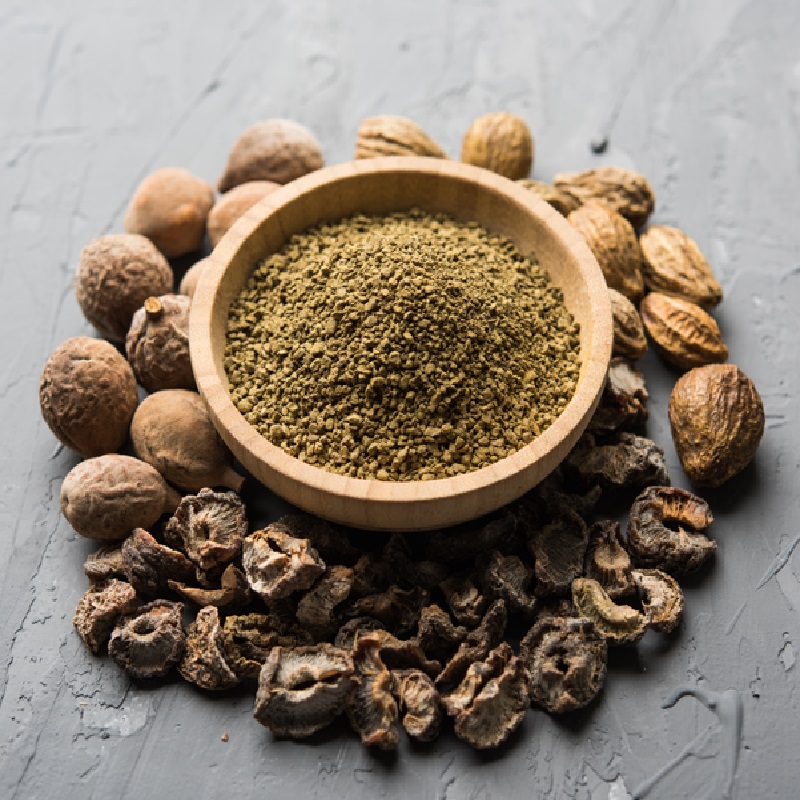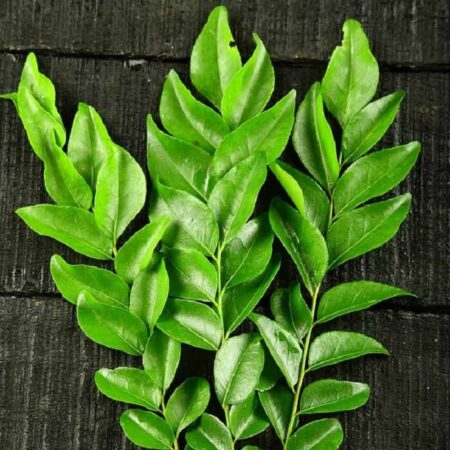
Triphala powder or Triphala churna is a popular ayurvedic remedy widely used for laxative properties, but it has numerous other health benefits like curing diabetes, improving eye health etc. Ayurveda uses plant-based remedies to cure various diseases – mentally and physically. It is an ancient Indian system of medicine is practised for at least 5000 years. Triphala is a very important remedy in Ayurveda as it helps balance the energies that govern the body. It is made of herbal fruits that have various healing effects. Let us understand more about Triphala churna benefits on health, skin and hair.
The benefits of Triphala Churna can be attributed to its anti-inflammatory and antioxidant properties that are useful to help treat many ailments (2). It has laxative and antibacterial properties too that help improve dental health, treat type 2 diabetes, enhance skin health, and stimulate hair growth.
In this article, we have included a holistic overview of the potential health benefits and types of Triphala, how to use it, its recommended dosage, how to make it at home, and the possible side effects.
Know Your Ingredient
What Is It?
Triphala is a traditional Ayurvedic herbal formulation consisting of three fruits: Amla, Bibhitaki, and Haritaki.
What Are Its Benefits?
Triphala aids in digestion, detoxification, and supports overall gastrointestinal health. It also promotes healthy skin, boosts immunity, and acts as a natural antioxidant.
Who Can Use It?
Triphala is generally safe for adults and can be used by individuals seeking digestive support, improved skin health, or a natural detoxification method.
How Often?
It is recommended to take Triphala once or twice daily, preferably before meals, in consultation with a healthcare professional.
Caution
Pregnant or breastfeeding women, as well as individuals with certain medical conditions or taking specific medications.
What Is Triphala?
Triphala is the amalgamation of two Sanskrit words – Tri, which means three, and Phala, which means fruit. This means Triphala is the mixture of three fruits in their dried and powdered form. Those include bibhitaki, amalaki, and haritaki.
As per Ayurveda, each fruit in Triphala is thought to positively impact the body’s three doshas – vata, pitta, and kapha. These doshas are believed to permeate body, mind, and spirit. It is believed in herbalism that the ingredients in Triphala can heal and balance these doshas to improve your health and wellness.
Triphala is composed of the following three fruits:
- Embilica officinalis, commonly known as amla or Indian gooseberry. This edible fruit has a sour taste and is often used to add flavor dishes (3).
These berries are rich in vitamins and minerals that can treat certain ailments such as inflammation, thyroid, cancer, neurological disorders, and osteoporosis (4).
- Terminalia bellirica is commonly referred to as bibhitaki or vibhidaka. It is best known for its anti-inflammatory and antioxidant properties (5).
As per Ayurveda, it is used to treat bacterial and viral infections. It contains flavones, tannins, and gallic acid that have immense medicinal values. Bibhitaki is used to regulate blood sugar levels and for weight management (6), (7).
- Terminalia chebula is also known as haritaki and harad. Haritaki is a popular remedy for intestinal and digestive issues such as constipation (8). It possesses antioxidant properties and is packed with phytochemicals.
Triphala is a mix of these three fruits that are dried and mixed in the right proportions. While the three are used separately for various treatments, together they make quite a potent treatment for a number of health problems (9).
Did You Know
Triphala is widely mentioned in the ancient Ayurvedic text Charaka Samhita. As per the text, a mix of triphala, honey, and ghee (Triphala Rasayana) can help you live longer.
There are three types of Triphala that are commonly used. Find out more about them in the next section.
Different Types of Triphala
As per Ayurveda, Triphala is of three types:
- Swalpa Triphala: Swalpa Triphala is also known as Maha Triphala. It consists of three fruits – draksha, parushaka, and kharjura (10).
- Madhura Triphala: Madhura Triphala is also known as Swadu Triphala. It consists of kharjura, kasmarya, and draksha. It is claimed to promote the desire for food and improve vision. It is also useful in alleviating irregular fever (10).
- Sugandhi Triphala: Sugandhi Triphala is a mix of lavangam, jatiphalam, and ela. It acts as an astringent and is useful in dealing with constipation problems caused by vata and kapha doshas (10).
Trivia
As per Ayurveda, triphala works as a bowel tonic when taken at low doses and purgative at high doses.
Now that you know the different types of Triphala, let’s check out its health benefits in the following section!
Health Benefits Of Triphala


1. May Protect Against Dental Disease And Cavities
The anti-inflammatory and antimicrobial properties of Triphala may help prevent dental problems such as plaque formation, gingivitis, fungal infections, and sores. A study conducted in Iran found that a mouthwash consisting of Triphala reduces microbial growth, dental plaque formation, and gingival inflammation (11), (12).
Another study conducted on hospitalized patients with periodontal diseasei XIt refers to the inflammation of gums caused by a bacterial infection, which may affect the bones surrounding the teeth. showed that treatment with a Triphala-based mouthwash reduces plaque and gum inflammation without any side effects (13).
A study in India has found that Triphala helps stop the growth of certain fungal species in the mouth (14).
2. May Helps To Treat Type 2 Diabetes
Triphala possesses hypoglycemic properties. This makes the intake of insulin by the cells easier and reduces the to take insulin in the form of shots. A study conducted on 150 people with diabetes found that Triphala reduces blood glucose levels (15).
Another study published in the International Journal of Ayurvedic Medicine states that Triphala may improve glucose homeostasisi XIt refers to steady blood glucose levels achieved by a balanced interaction of the hormones glucagon and insulin. by alleviating oxidative stress (16). The amla in Triphala also has some antidiabetic properties that may help in preventing and treating diabetes (17).
3. May Improves Skin Health


Triphala has a protective effect on dermal fibroblasts and keratinocytes. This means it may help rebuild the dermis layer and aid recovery from injury. It may also prevent darkening, skin damage, and aging (18).
Its anti-inflammatory and antioxidant properties may help heal certain skin ailments. A study conducted by SGT University (India) found that Triphala may help increase collagen formation and have an antibacterial effect, which may aid wound healing (19). Triphala is also rich in flavonoids and antioxidants that may delay aging (20).
- May Rejuvenate Skin
This herbal powder is claimed to moisturize, smoothen, and soften your skin, and also help in rejuvenation. This is attributed to the antioxidant compounds present in Triphala that clear pigmentation and help kill the acne-causing bacteria. This characteristic, along with its emollient property, make Triphala ideal for soothing dry and flaky skin. However, limited research is available to support this claim.
- May Reduce Dark Circles
Using Triphala water as an eyewash is said to be one of the best ways to get rid of puffy eyes and under-eye dark circles. Add a small amount of Triphala powder in water and wash your eyes thoroughly with it. It is said to refresh your eyes and reduce puffiness. Though there is insufficient scientific evidence available to support this claim, it is backed by tons of anecdotal evidence.
4. May Stimulate Hair Growth And Treat Dandruff


The emollient properties of Triphala lock moisture in the hair and prevent alopecia. Mix Triphala and water and drink it like a tonic or apply it topically to help stimulate hair growth (10). As Triphala possesses antifungal properties, it may help in treating dandruff. However, more research is required to prove this claim. To use Triphala to reduce dandruff, just mix two tablespoons of Triphala powder in 4-5 tablespoons of water and massage the paste gently on the scalp. Wash it off after 20-30 minutes.
5. Helps In Weight Loss
Triphala can be consumed as a supplement for weight loss as it controls the satiety center by inducing the secretion of cholecystokinin (a hormone that is released by your body to indicate that you are full) (21). A study conducted on mice on a high-fat diet found that Triphala and its constituents act as anti-obesity agents and reduce body weight (22).
The antioxidant property and hydroxyl and nitric oxide radicals present in Triphala help in reducing body weight and body mass index (BMI) (23).
6. Reduces Stomach ulcers
Triphala exhibits an ulcer ameliorative effect on gastric ulcers by strengthening the gastric mucosa and restoring the free radical-scavenging enzymes in the intestine (24).
7. Improves Digestive health


Triphala works effectively as an alternative to a laxative and can be used to stimulate bowel movements (25). It can also reduce intestinal inflammation (26). People with digestive problems or bowel movement issues can have one spoon of Triphala before going to bed to make sure their colon remains healthy. You can also take a spoon early in the morning on an empty stomach with loads of water to bid farewell to bloating, upset stomach, and diarrhea.
To get rid of constipation, have a glass full of warm water with 2 teaspoons of Triphala powder every night. Make sure you don’t eat anything after having it. However, you may have water after half an hour.
8. May Protect Against Certain Cancers
Triphala contains antioxidants that may possess cancer-fighting properties (27). These antioxidants may act against certain types of cancers such as lung, liver, skin, and breast (28).
Animal studies have exhibited the cytotoxic effect of Triphala. A substantial regression in tumor cells has been seen in mice that were fed Triphala (29). In vivo studies have proved that Triphala is effective in inhibiting pancreatic tumor growth (30).
However, more research is required to understand the cancer-fighting property of Triphala on humans.
9. May Provide Relief From Arthritis And Gout
Triphala exhibits anti-inflammatory properties that have the potential to provide relief from joint pain, arthritis, and gout (31), (32). It provides nutrients that help strengthen your bones and flush out the excess uric acid that is responsible for inflammation. Triphala has also been found to reduce cartilage and bone degradation in arthritic rats (1).
10. May Help Reduce Stress and Anxiety


Triphala possesses de-stressing properties, which may help in treating stress- and anxiety-related disorders. Triphala has been found to prevent noise-induced metabolic changes in rats by mediating immune responses to reduce stress levels (1). However, more research is required to understand this effect of Triphala on humans.
11. May Boost Immune Health
Triphala is rich in vitamin C that may help in improving your immune system (33). It also aids in the cleansing and detoxification of your digestive and gastric tract, which may help improve your digestion as well as immunity (25).
12. May Improve Eye Health
Triphala is a potent eye tonic that can keep your eyes healthy and vision sharp. It also possesses some anticataract properties (34). You may consume Triphala orally or use it as an eyewash to get rid of any eye infections.
Triphala eye drops can help in reducing the symptoms of “computer vision syndrome” like dry and irritated eyes, excessive secretion of tears, and light or glare sensitivity (35).
You can soak about 1-2 spoons of Triphala powder in warm water overnight. In the morning, strain the soaked mixture and use it to clean your eyes.
This simple remedy can keep your eyes healthy and infection-free.
Pro Tip
Ancient Ayurvedic texts mention using triphala to treat eye conditions. Triphala ghrita (a blend of triphala and ghee) is still used to treat conditions like conjunctivitisi XAn inflammation of the eyelid’s inner surface and the outermost layer due to infection or an allergic reaction. , eye pain, and itching.
13. Treats Urinary Tract Infections (UTIs)
Urinary tract infections can be very difficult to treat with modern medicine as the infections tend to become resistant to antibiotics. Most UTI patients rely on alternative treatments and conventional medicine. UTIs can be very dangerous as they can damage the kidneys and other organs in the body. Triphala is one of the top ayurvedic remedies to treat UTIs as it treats the root cause of the disease and helps eliminate the infections permanently.
14. Lowers Cholesterol
Triphala is high in linoleic and oleic acids. These acids are very helpful in boosting heart health and preventing heart disease. Linoleic acid is an essential compound that helps increase the good cholesterol levels in the body and ward off bad cholesterol that has harmful effects on the heart. Triphala churna is also very effective in lowering blood pressure, which is very important for maintaining heart health.
15. Triphala Powder for Grey Hair
Triphala is an excellent remedy for treating and preventing premature greying of hair. Triphala powder can be mixed with any nourishing hair oil like coconut oil or bhringraj oil and applied on the scalp regularly. Such scalp massages with Triphala powder help stimulate the pigmentation of the hair and prevent hair greying or white hair.
How To Use Triphala
Triphala is available in different forms, including capsules, tablets, powder (tea and face packs), and liquid (eyewashes).
- Triphala Capsules And Tablets: Triphala tablets or capsules are the better options for people who can’t take this herbal preparation in the form of powder. However, ensure that you do not consume it in excess amounts.
- Triphala Tea: Triphala can be consumed in the form of tea. Add a teaspoon of Triphala to a cup of water and boil it. For taste, add honey. It is safe to consume this tea two to three times a day. However, excess intake may lead to some side effects.
- Triphala Eyewash: Triphala is beneficial in maintaining your eye health. Make Triphala eyewash by mixing a teaspoon in a glass of water and letting it soak overnight. Use this water as an eyewash in the morning for better results.
- Triphala Face Pack: Triphala may help in improving skin health. You can mix a tablespoon of Triphala powder with some coconut oil and apply it to your face. Leave this pack on for 10 to 15 minutes, then rinse it off with warm water. In case you experience an allergic reaction after applying it, consult a doctor immediately.
- Triphala With Lemon And Honey: You can mix lemon and honey with Triphala and consume it. However, take Triphala with warm water and without any additives to reap the maximum benefits. You can also mix Triphala with milk or ghee. Consume this solution on an empty stomach or before meals for maximum absorption. Some people prefer consuming Triphala with warm water before going to bed. You can discuss your options with your doctor before starting this treatment.
Here’s how much Triphala you are recommended to take…
Dosage
The recommended dose of Triphala ranges from 500 mg to 1 gram per day.
When To Consume Triphala Powder
- The time of the day of consuming this remedy depends on the condition we want to treat.
- If you want to use Triphala for laxative benefits or toxic cleansing, you must consume this churna at night before bed.
- Taking Triphala at night helps in regulating the stomach flora, treats mucous build-up, cleans the lungs and treats respiratory disorders.
- If you want to use Triphala to treat diabetes, regulate blood sugar levels and burn body fat, you must consume it early in the morning on empty stomach.
Here’s how you can make Triphala Churna at home.
How To Make Triphala Powder At Home
Just buy these ingredients and make your dose of health in the confines of your home.
What You Need
Before buying the ingredients, keep in mind that they need to be in the ratio 1:2:4 (Harad:Baheda:Amla). Decide your quantities accordingly. Here we have taken 20 g of harad.
- Harad – 20 g
- Baheda – 40 g
- Amla – 80 g
- Mortar and pestle
What You Need To Do
- Grind all the raw ingredients into a fine powder with the help of a mortar and pestle.
- Filter the powder individually and pour them in individual stone bowls.
- Now, mix these powders in the ratio of 1:2:4.
Transfer the new mixture into a jar and store it for future use.
Though Triphala is generally safe for consumption, it does have a few side effects that you need to keep in mind. Check them out in the next section.
Potential Side Effects And Risks Of Triphala
This herbal medicine may cause some side effects when consumed in high doses. It may lower blood sugar levels too much, interfere with certain medications, and lead to harmful effects in pregnant women.
1. May Lower Blood Sugar Too Much
Triphala can interact with diabetes medication and cause a drop in your blood sugar levels. Menthol and sorbitol, two active ingredients of Triphala, are responsible for this action (15).
Though there is no direct research stating that Triphala lowers blood sugar levels, it is a possibility as it has antidiabetic properties. Therefore, consult your doctor before taking Triphala if you have diabetes.
2. May Interfere With Certain Drugs
Triphala was found to inhibit the activity of cytochrome P450, a family of enzymes found in liver cells (36).
In one study, a patient given a herbal mixture containing Triphala developed experienced two relapses of depression. Symptoms like sleep disturbances, low mood, and reduced energy followed. These symptoms improved once the patient stopped taking the herbal medication (37).
It is unclear which medications Triphala interferes with. Hence, if you are on any medication, please consult your doctor before taking Triphala.
3. May Cause Pregnancy Complications
One report states the potentially harmful effects of Terminalia chebula, an active ingredient in Triphala, during pregnancy. This ingredient is said to cause abortion of the fetus. It could also cause heartburn, constipation, nausea, and diarrhea in pregnant women (38). However, there is not much research currently available to establish this.
Anecdotal evidence also suggests that Triphala may not be suitable for kids. More research is being done on the possible adverse effects of Triphala on children.
Triphala is an herbal concoction that has been used in traditional Ayurvedic medicine for its medicinal value. The high antioxidant and polyphenolic content is responsible for many benefits of Triphala. It is a combination of three plants and exhibits anti-inflammatory, anti-bacterial, and laxative properties. The use of Triphala may protect against dental diseases and cavities, help treat type 2 diabetes, improve skin health, stimulate hair growth, and treat dandruff. However, excess consumption may cause hypotensioni XIt is the medical term for low blood pressure levels (a reading below 90/60 mmHg) and may cause dizziness. , interfere with certain drugs, and cause pregnancy complications. Hence, use it in the recommended dosage and consult your doctor or consult herbalist in any emergencies.
Frequently Asked Questions
Where can one get Triphala Churna?
The best thing about Ayurvedic medicine is that it can be made easier with a few simple ingredients that are easily available in your kitchen or in the market. One can get the three fruits, dry them in the sun properly, grind them, and mix them at home for the best results. However, for those who have no time to make it, it is also easily available in the market and online. So, simply buy and use it!What brands are good for Triphala tablets and churna?
If you are looking for pure and genuine products, I would suggest you go for famous yet easily available brands such as Dabur, Organic India, and Himalaya.Does Triphala affect the kidneys?
Triphala has a protective effect on kidney function. As per research, it can help reduce oxidative stress and prevent kidney damage (49).Can Triphala cure fatty liver?
Triphala can help manage the symptoms and facilitate the healing of non-alcoholic fatty liver that is caused by obesity (40).Is Triphala acidic or alkaline?
Each of the three ingredients in Triphala are alkaline in nature.Does triphala detox your body?
Triphala is efficient in detoxifying the body and getting rid of harmful toxins. This wonderful churna gets rid of all dead cells from the skin by making it glow naturally. The richness of antioxidants in triphala supports the bowel health, digestion process and helps in detoxification.
Key Takeaways
- Triphala may help protect the body from cancer and inflammation-causing free radicals.
- Its daily consumption may promote digestive health and bowel movement.
- Triphala boosts immunity against infections and diseases.
- It improves blood circulation and regulates blood sugar, which may help manage diabetes and obesity.




























